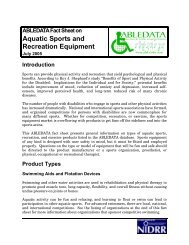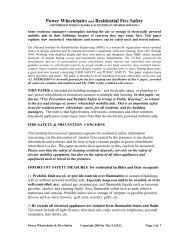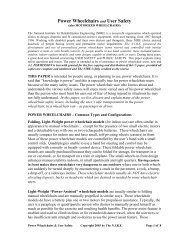ABLEDATA Fact Sheet On Manual Wheelchairs
ABLEDATA Fact Sheet On Manual Wheelchairs
ABLEDATA Fact Sheet On Manual Wheelchairs
Create successful ePaper yourself
Turn your PDF publications into a flip-book with our unique Google optimized e-Paper software.
Some wheelchairs for children are designed with features that allow them to be<br />
converted to accommodate growth such as variable seat width and depth, adjustable<br />
axle and seat heights, and height adjustable footrests. Adjustments or adaptations to<br />
account for growth may include installing replaceable components or designing the<br />
chair with features that can be converted from a smaller size to a larger size.<br />
For more information on wheelchairs for children, including manual and powered<br />
models, see <strong>ABLEDATA</strong>’s <strong>Fact</strong> <strong>Sheet</strong> on <strong>Wheelchairs</strong> for Children.<br />
Figure 2: The Levo Kid from Levo USA is a child's standing wheelchair.<br />
Institutional, Nursing Home or Depot <strong>Wheelchairs</strong><br />
An institutional wheelchair is generally the least expensive type of chair available. It is<br />
designed for institutional usage only, such as transporting patients in hospitals or<br />
nursing homes. An institutional wheelchair is not an appropriate alternative for anyone<br />
who requires independent movement, as it is not fitted for a specific individual. These<br />
types of chairs are now also used as rental chairs and by businesses and some public<br />
facilities (such as grocery stores and airports) for temporary use.<br />
Lightweight <strong>Wheelchairs</strong><br />
Lightweight wheelchairs have frames made of lighter materials such as aluminum,<br />
titanium, or chrome. Originally developed for racing and wheelchair sports, these chairs<br />
have become increasingly popular as daily use chairs. Many active wheelchair users<br />
prefer the sportier look of the lightweights compared with the more plain-looking<br />
everyday chair. Lighter chairs can also be easier to transport. They offer independence<br />
of movement with minimum effort for persons with good upper body mobility. It<br />
should be noted, however, that heavy or obese persons may be unable to use these types<br />
of chairs because the lighter weight of the frame results in a reduced user capacity as<br />
compared to standard everyday chairs. Lightweight chairs typically weigh less than 30<br />
pounds without legrests and/or wheels. Some models have folding frames, some have<br />
rigid frames, and a few offer a choice of frame styles.<br />
<strong>ABLEDATA</strong> <strong>Fact</strong> <strong>Sheet</strong> on March 2006 Page 3<br />
<strong>Manual</strong> <strong>Wheelchairs</strong>







